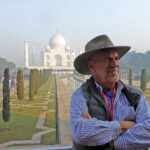The following lecture videos were initially presented by the Arizona Senior Academy as webinars. The presenters have agreed to include their webinar presentations as videos on this list. The videos have been placed on this page 10 days or more following the initial presentation, and withdrawn several months following the presentation. The first one on the right (Fenstermacher) is particularly helpful for those new to Academy Village.
Enjoy!
April 10: Marcia Neugebauer–“What’s Going On in Space?
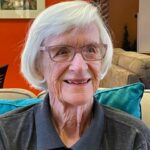 Dr. Marcia Neugebauer, an internationally recognized space physicist and Academy Village resident, explains important developments in space projects–both the scientific research missions, and the benefits and dangers of new technology that is being launched on an almost daily basis. She also describes the incredible proliferation of earth orbiting satellites–and how the dangerous debris in space as well as the number of orbiting satellites could result in collisions.
Dr. Marcia Neugebauer, an internationally recognized space physicist and Academy Village resident, explains important developments in space projects–both the scientific research missions, and the benefits and dangers of new technology that is being launched on an almost daily basis. She also describes the incredible proliferation of earth orbiting satellites–and how the dangerous debris in space as well as the number of orbiting satellites could result in collisions.
April 8: Goggy Davidowitz–“Feeding the World with Edible Insects”
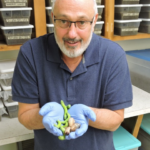 By the year 2050, the world will not be able to produce enough protein to sustain human population. Dr. Davidowits, a professor or Entomology, U of A, describes the search for novel alternative production solutions. For example, insects are highly nutritious, and more sustainable than vertebrate livestock. The edible insect industry is experiencing huge growth worldwide including the U.S. Unique solutions are described including some at the U of A. Click here.
By the year 2050, the world will not be able to produce enough protein to sustain human population. Dr. Davidowits, a professor or Entomology, U of A, describes the search for novel alternative production solutions. For example, insects are highly nutritious, and more sustainable than vertebrate livestock. The edible insect industry is experiencing huge growth worldwide including the U.S. Unique solutions are described including some at the U of A. Click here.
March 27: Christopher Bailey–“The Patient’s Guide to Pain Management
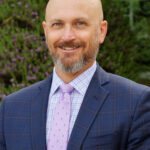 Although pain is one of the most common human experiences, the science of pain research and management is a relatively new field. Dr. Bailey, from the Pain Institute of Southern Arizona, describes the importance of pain clinics that specialize in the diagnosis and management of chronic pain and work to eliminate it with the goal of improving quality of life. He explains exciting new developments on the horizon for those who want to live with reduced or no pain. Click here
Although pain is one of the most common human experiences, the science of pain research and management is a relatively new field. Dr. Bailey, from the Pain Institute of Southern Arizona, describes the importance of pain clinics that specialize in the diagnosis and management of chronic pain and work to eliminate it with the goal of improving quality of life. He explains exciting new developments on the horizon for those who want to live with reduced or no pain. Click here
March 25: Randolph Nesse–“Why Aging Exists at all, and the Origins of Evolutionary Medicine”
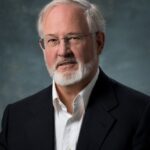 Dr. Randolph Nesse discusses his research program that has led to the new field of Evolutionary Medicine, and how these insights can help us understand our own aging. He describes his bringing together of a several fields of psychiatry, psychology and biology to examine our understanding of the process and issues related to aging. Click here
Dr. Randolph Nesse discusses his research program that has led to the new field of Evolutionary Medicine, and how these insights can help us understand our own aging. He describes his bringing together of a several fields of psychiatry, psychology and biology to examine our understanding of the process and issues related to aging. Click here
March 18: Lalitha Madhaven–“Novel regenerative Medicine-based Approaches for Parkinson’s Disease”
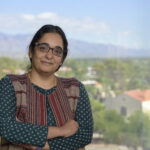 Dr. Madhaven, Associate Professor of Neurology, U of A, is working on developing rational therapeutic strategies to tackle aging and age related disorders such as Alzheimer’s and Parkinson’s Disease. She explains how she uses induced pluripotent stem cell technology that may be useful in uncovering the mechanisms underlying Parkinson’s Disease. Click here
Dr. Madhaven, Associate Professor of Neurology, U of A, is working on developing rational therapeutic strategies to tackle aging and age related disorders such as Alzheimer’s and Parkinson’s Disease. She explains how she uses induced pluripotent stem cell technology that may be useful in uncovering the mechanisms underlying Parkinson’s Disease. Click here
March 13: Luke Cole–“The Santa Cruz River: How We Got Here and Where We’re Going”
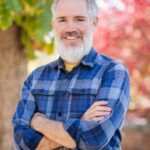 The Santa Cruz River has sustained humans in this region for over 12,000 years, and is the home of the longest continuous agricultural in the U.S., dating back 4,000 years. Since the 1800’s the Santa Cruz River has been overdrawn, polluted and abandoned. Within the last 15 years, the Santa Cruz has undergone a revitalization. Dr. Luke Cole is the director of the Santa Cruz River program within the Sonoran Institute, and describes the “journey” of the river and the Institute’s efforts to assure that it’s rebirth continues. Click here
The Santa Cruz River has sustained humans in this region for over 12,000 years, and is the home of the longest continuous agricultural in the U.S., dating back 4,000 years. Since the 1800’s the Santa Cruz River has been overdrawn, polluted and abandoned. Within the last 15 years, the Santa Cruz has undergone a revitalization. Dr. Luke Cole is the director of the Santa Cruz River program within the Sonoran Institute, and describes the “journey” of the river and the Institute’s efforts to assure that it’s rebirth continues. Click here
March 11: Julia Strange & Heather Beck–“TMC Healthcare: Yesterday, Today, Tomorrow”

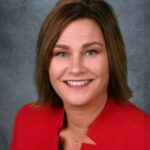 Julia Strange, (left) VP of TMC Healthcare, and Heather Beck (right), TMC Rincon Hospital Administrator briefly describe the long history of the Tucson Medical Canter since 1944. The Hospital has remained a non-profit Institution throughout all these years. A brand new Rincon TMC will be investing in and developing new ways of meeting the needs of the Rincon area. Eastside residents will see the advantages of using TMCOne for their medical needs. Click here
Julia Strange, (left) VP of TMC Healthcare, and Heather Beck (right), TMC Rincon Hospital Administrator briefly describe the long history of the Tucson Medical Canter since 1944. The Hospital has remained a non-profit Institution throughout all these years. A brand new Rincon TMC will be investing in and developing new ways of meeting the needs of the Rincon area. Eastside residents will see the advantages of using TMCOne for their medical needs. Click here
March 6: Peter Medine–“Three Shakespeare Sonnets: the Lyric Poem and the Subject of Romantic Love”
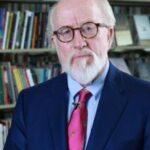 Shakespeare’s Sonnets loom Everest-like in the tradition of English lyric poetry. Dr. Medine, professor emeritus of the U of A., inquires into the source of the collection’s pre-eminence through an examination of three of its sonnets: Nos. 116, 129, and 29. By attending to metrics, rime, figurative language, and structure, we see Shakespeare develop, broaden, and deepen the poetic significance of his subject. Click here
Shakespeare’s Sonnets loom Everest-like in the tradition of English lyric poetry. Dr. Medine, professor emeritus of the U of A., inquires into the source of the collection’s pre-eminence through an examination of three of its sonnets: Nos. 116, 129, and 29. By attending to metrics, rime, figurative language, and structure, we see Shakespeare develop, broaden, and deepen the poetic significance of his subject. Click here
Feb. 28: Jerry Newman–“A Journey Through Central Europe
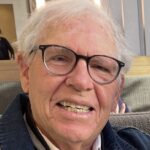 Dr. Jerry Newman, professor emeritus of History at Kent State University, shares an 18 day journey taken with his wife, Barbara, through Coatia, Slovenia, Austria and Poland. Both taught generalized European history for many years, and their sense of history through experiencing these countries. Click here
Dr. Jerry Newman, professor emeritus of History at Kent State University, shares an 18 day journey taken with his wife, Barbara, through Coatia, Slovenia, Austria and Poland. Both taught generalized European history for many years, and their sense of history through experiencing these countries. Click here
Feb. 26: Alex LaPierre–“Alamos: A Colonial Silver Town in the Dry Topics”
 Alex LaPierre, co-founder ot Borderland, takes us on a trip to one of Mexico’s magical cities, Alamos, Sonora. It is located between the desert and the tropics. He introduces the colonial architecture of the city and how its existence is a testimony to the cleverness of past peoples and a key to how to live and thrive in a desert environment. He discusses the cultural mores of a people and how they are rooted in survival, not only of the desert, but also the frontier issues over time. Click here
Alex LaPierre, co-founder ot Borderland, takes us on a trip to one of Mexico’s magical cities, Alamos, Sonora. It is located between the desert and the tropics. He introduces the colonial architecture of the city and how its existence is a testimony to the cleverness of past peoples and a key to how to live and thrive in a desert environment. He discusses the cultural mores of a people and how they are rooted in survival, not only of the desert, but also the frontier issues over time. Click here
Feb. 21: Ibrahim Garba– “Nations and Families of Nations: Indigenous Peoples in modern Nation-States”
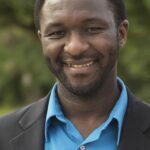 Respecting the concerns of Indigenous communities is a responsibility of more industrialized societies. These societies absorb an unjustly high percentage of the negative impacts of extractive and industrial development projects such as mining and logging. Garba, a student of philosophy and international human rights law, and a research professor at the College of Public Health, U of A focuses, among other topics, on the implications of the ethical conduct of health research in low resource settings. Click here
Respecting the concerns of Indigenous communities is a responsibility of more industrialized societies. These societies absorb an unjustly high percentage of the negative impacts of extractive and industrial development projects such as mining and logging. Garba, a student of philosophy and international human rights law, and a research professor at the College of Public Health, U of A focuses, among other topics, on the implications of the ethical conduct of health research in low resource settings. Click here
Feb. 19: Albrecht Class”Myth Busting: Global Contacts in the Pre-Modern World”
 It is common among modern historians to assert that globalism emerged only around 1800. However, Dr. Claussen indicates that texts, images, ideas, knowledge, and objects migrated throughout the world in pre-modern times. Claussen uncovers hard-core facts of global economic exchange and the impact of exotic medicine, as well as intensive debates on religious issues. Click here
It is common among modern historians to assert that globalism emerged only around 1800. However, Dr. Claussen indicates that texts, images, ideas, knowledge, and objects migrated throughout the world in pre-modern times. Claussen uncovers hard-core facts of global economic exchange and the impact of exotic medicine, as well as intensive debates on religious issues. Click here
Jan. 31: Lucy Swanson–“The Zombie in Contemporary French Caribbean Fiction”
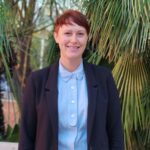 This lecture explores the origins of the zombie in African spirit beliefs and the Caribbean popular imaginary, and traces its evolution from depicting a victim of enslavement to that of a bloodthirsty monster found in films such as George Romero’s Night of the Living Dead (1968). Dr. Swanson, University of Arizona, then discusses how contemporary Haitian writers reimagine the figure today. Click here
This lecture explores the origins of the zombie in African spirit beliefs and the Caribbean popular imaginary, and traces its evolution from depicting a victim of enslavement to that of a bloodthirsty monster found in films such as George Romero’s Night of the Living Dead (1968). Dr. Swanson, University of Arizona, then discusses how contemporary Haitian writers reimagine the figure today. Click here
Jan. 29: Craig Nazareth & Alexander Szokoly–“Russo-Ukrainian War: 2024 Outlook”
 2024 will
2024 will bring tactical challenges in Ukraine’s effort to repel Russian advances. I Russia is to achieve its goals, it will have to increase its combat power and mobilizations. This would be highly dependent on western support. Professor Nazareth and Mr. Szokoly will discuss the insight their military experience gives them in predicting the future course of this war. Click here
bring tactical challenges in Ukraine’s effort to repel Russian advances. I Russia is to achieve its goals, it will have to increase its combat power and mobilizations. This would be highly dependent on western support. Professor Nazareth and Mr. Szokoly will discuss the insight their military experience gives them in predicting the future course of this war. Click here
Jan 22: Bob Smith & Brack Brown–“The Evolution of the Coral Reef Mural”
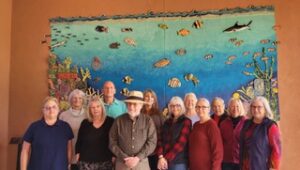 This presentation documents the evolution of the large, outdoor, Coral Reef Mural from inspiration to dedication in photos. The mural’s inscription is “Let us cherish and protect the Ocean–Ancient Birthplace of all Life. . .” The entire creation took over two years of a large group of dedicated volunteers. Click here
This presentation documents the evolution of the large, outdoor, Coral Reef Mural from inspiration to dedication in photos. The mural’s inscription is “Let us cherish and protect the Ocean–Ancient Birthplace of all Life. . .” The entire creation took over two years of a large group of dedicated volunteers. Click here
January 17: Peter Medine: “The Character of Macbeth: His Conscience and His Tragedy”
 Dr. Medine , Professor Emeritus at the U of Arizona, describes the two opposing aspects of Macbeth’s character, the heroic and the criminal, and how they touch on the mystery of the evil of which the most gifted and morally astute beings may be capable. Macbeth stands out for his criminality; at the same time, Shakespeare invests him with an extraordinary conscience. Click here
Dr. Medine , Professor Emeritus at the U of Arizona, describes the two opposing aspects of Macbeth’s character, the heroic and the criminal, and how they touch on the mystery of the evil of which the most gifted and morally astute beings may be capable. Macbeth stands out for his criminality; at the same time, Shakespeare invests him with an extraordinary conscience. Click here
Jan. 10: Teadora Georgieva: “CRISPR: A Game-Changing Genetic Engineering Technique”
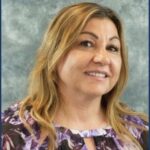 CRISPR, a game-changing engineering technique, is a powerful tool for gene and genome edit. CRISPR works in almost every organism: plants, small and large animals, and humans. Dr. Teadora Georgieva, Director of GEMM Core, helps us understand the capabilities of this remarkable technique. Click here
CRISPR, a game-changing engineering technique, is a powerful tool for gene and genome edit. CRISPR works in almost every organism: plants, small and large animals, and humans. Dr. Teadora Georgieva, Director of GEMM Core, helps us understand the capabilities of this remarkable technique. Click here
Jan. 8: Robert Linden and Maureen Orr: “One Couple’s Humanitarian Response to Health Care in the Third World”
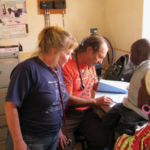 Doctors Without Borders provides independent, impartial medical humanitarian assistance to those affected by conflict, disease outbreaks, natural and human-made disasters in more than 70 countries. Dr. Bob and Nurse Maureen share their experiences in five different areas of the world between 2004 and 2012: Sumatra; West Nile, Uganda, Abkhazia, and Papua, New Guinea. Click here
Doctors Without Borders provides independent, impartial medical humanitarian assistance to those affected by conflict, disease outbreaks, natural and human-made disasters in more than 70 countries. Dr. Bob and Nurse Maureen share their experiences in five different areas of the world between 2004 and 2012: Sumatra; West Nile, Uganda, Abkhazia, and Papua, New Guinea. Click here
Dec. 20: Sabrina Helm: “The Effect of Climate Change as a Pre-Traumatic Stress
 As a result of global environmental changes, we are now facing a mental health crisis related to environmental issues such as climate anxiety, distress, and grief. Dr. Sabrina Helm is Associate Professor of Retailing and Consumer Science at the U of A, is particularly interested in the role of consumption in the context of climate change, psychological responses to the threat of climate change, and increased consumer resilience. Click here
As a result of global environmental changes, we are now facing a mental health crisis related to environmental issues such as climate anxiety, distress, and grief. Dr. Sabrina Helm is Associate Professor of Retailing and Consumer Science at the U of A, is particularly interested in the role of consumption in the context of climate change, psychological responses to the threat of climate change, and increased consumer resilience. Click here
Dec. 18: John Bauschatz: “Crime and Punishment in the Ancient World”
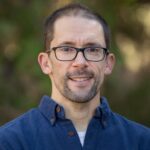 John Bauschatz is an Associate Professor of History and Classics at the U of A. He highlights some of the fascinating evidence we have for law and order in the Ancient Mediterranean world. Of central importance in this talk is the issue of boundaries: between right and wrong, imprisonment and freedom, individual and state. The talk examines law codes, tomb robbery, the trial and execution of Socrate, and death by gladiator. Click here
John Bauschatz is an Associate Professor of History and Classics at the U of A. He highlights some of the fascinating evidence we have for law and order in the Ancient Mediterranean world. Of central importance in this talk is the issue of boundaries: between right and wrong, imprisonment and freedom, individual and state. The talk examines law codes, tomb robbery, the trial and execution of Socrate, and death by gladiator. Click here
Dec. 13: Bryan Heidorn–“Misinformation: Carl Sagan’s Baloney Detection Tool Kit for 2003-2004”
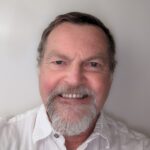 P. Bryan Heidorn, Associate Dean for Research and Graduate Affairs, U 0f A, examines Carl Sagan’s Baloney Detection Kit as a means to think critically and get closer to the truth. He updates the tookkit and adds a few new cognitive tools to deal better with today’s fractured information landscape. He also examines AI and how other algorithms are helping to spread untruth and how the same methods are being used tin baloney detection. Click here
P. Bryan Heidorn, Associate Dean for Research and Graduate Affairs, U 0f A, examines Carl Sagan’s Baloney Detection Kit as a means to think critically and get closer to the truth. He updates the tookkit and adds a few new cognitive tools to deal better with today’s fractured information landscape. He also examines AI and how other algorithms are helping to spread untruth and how the same methods are being used tin baloney detection. Click here
Dec. 11: Alex La Pierre: “Borderlandia”
 Alex La Pierre, Director of Bordlandia, takes us on a vicarious trip to Rocky Point, a fishing port nestled on the shores of the Sea of Cortez; and El Pinnate y Gran Alter UNESCO Biosphere Reserve, a vast wilderness area, home to some of Mexico’s most stunning geological formations. Click here
Alex La Pierre, Director of Bordlandia, takes us on a vicarious trip to Rocky Point, a fishing port nestled on the shores of the Sea of Cortez; and El Pinnate y Gran Alter UNESCO Biosphere Reserve, a vast wilderness area, home to some of Mexico’s most stunning geological formations. Click here
Dec. 4: Norm Scott: “Toward a Sustainable and Circular Food and Agricultural System”
 No area of human activity is more essential that a sustainable Food and Agricultural System (FAS). Agricultural productivity has been a strong focus during the 20th and 21st centuries. Climate change, conflicts, disruptions and wars globally impact the FAS. Science and technology have been key in generating the past transformation of food and agricultural systems; and this will remain so. A place must be found between local practices, and a concentrated agri-food sector. Professor Emeritus, Norm Scott Cornell University, will discuss these issues for the future of food production. Click here
No area of human activity is more essential that a sustainable Food and Agricultural System (FAS). Agricultural productivity has been a strong focus during the 20th and 21st centuries. Climate change, conflicts, disruptions and wars globally impact the FAS. Science and technology have been key in generating the past transformation of food and agricultural systems; and this will remain so. A place must be found between local practices, and a concentrated agri-food sector. Professor Emeritus, Norm Scott Cornell University, will discuss these issues for the future of food production. Click here
Nov. 29: Dan Engeljohn: “Leftovers and Food Safety”
 One in six Americans succumb to food borne illnesses each year. Dr. Engeljohn discusses the food and practices contribute most to food borne illness, hospitalizations, and death. Formerly head of the food safety policy office at the U.S. Dept. of Agriculture, Dr. Engeljohn moved to Tucson, and taught food safety and animal product practices at the University of Arizona. In his presentation he discusses the best practices to keep you safe on a daily basis. Click here
One in six Americans succumb to food borne illnesses each year. Dr. Engeljohn discusses the food and practices contribute most to food borne illness, hospitalizations, and death. Formerly head of the food safety policy office at the U.S. Dept. of Agriculture, Dr. Engeljohn moved to Tucson, and taught food safety and animal product practices at the University of Arizona. In his presentation he discusses the best practices to keep you safe on a daily basis. Click here
Nov. 27–Karl Flessa: “The Binational Effort to Restore the Colorado Delta”
 Since ~1935, upstream water diversions have reduced the amount of water that reaches the Colorado River’s Delta in the northern Gulf of California. In most years, the river no longer reaches the sea.Professor Karl Flessa, Professor of Geosciences at the U of A, has helped coordinate scientific monitoring of the effects of environmental flows to the Colorado River Delta. This presentation explores the history of the Colorado River Delta and the impact of work being done on restoring the delta. Click here
Since ~1935, upstream water diversions have reduced the amount of water that reaches the Colorado River’s Delta in the northern Gulf of California. In most years, the river no longer reaches the sea.Professor Karl Flessa, Professor of Geosciences at the U of A, has helped coordinate scientific monitoring of the effects of environmental flows to the Colorado River Delta. This presentation explores the history of the Colorado River Delta and the impact of work being done on restoring the delta. Click here
Nov. 22: Bruce Chamberlain: “Deep Dive into Classical Masterworks: Bach’s St. John Passion: 300 Years Later”
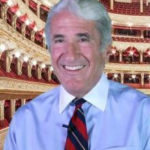 Why are some composers of the past still played and enjoyed today. During Lent of 2024, Bach’s monumental St. John Passion will turn 300 years old and we are still listening to it? UA Professor Emeritus will provide some insight into this question, along with creating some context to the genre of Passion music and its history. Click here
Why are some composers of the past still played and enjoyed today. During Lent of 2024, Bach’s monumental St. John Passion will turn 300 years old and we are still listening to it? UA Professor Emeritus will provide some insight into this question, along with creating some context to the genre of Passion music and its history. Click here
Nov. 13–Richard L. Poss: “Leonardo da Vinci: Art and Astronomy in the Florentine Renaissance”
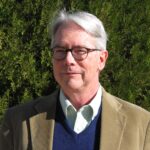 As one of the towering figures of Renaissance painting, Leonardo da Vinci had many other interests. He pursued scientific investigations; and his work contains remnants of Aristotelian physics and scientific endeavors–particularly in his astronomical writings. Dr. Poss, an Associate Professor of Astronomy at the U of A, examines Leonardo’s artistic and scientific endeavors with particular attention to his astronomical writings. Click here
As one of the towering figures of Renaissance painting, Leonardo da Vinci had many other interests. He pursued scientific investigations; and his work contains remnants of Aristotelian physics and scientific endeavors–particularly in his astronomical writings. Dr. Poss, an Associate Professor of Astronomy at the U of A, examines Leonardo’s artistic and scientific endeavors with particular attention to his astronomical writings. Click here
Nov. 6–Charles Scruggs: “Boats Against the Current”: The Fiction of Edith Wharton and F. Scott Fitzgerald
 Professor Emeritus Charles Scruggs discusses the work of Edith Wharton–the first woman to win the pulitzer Award in Fiction and seen as an American Victorian–and F. Scott Fitzgerald, best known for depicting the flamboyance and excess of the Jazz Age. Scruggs describes their works, contrasts these two iconic American authors, and discusses their views of each others’ works. Click here
Professor Emeritus Charles Scruggs discusses the work of Edith Wharton–the first woman to win the pulitzer Award in Fiction and seen as an American Victorian–and F. Scott Fitzgerald, best known for depicting the flamboyance and excess of the Jazz Age. Scruggs describes their works, contrasts these two iconic American authors, and discusses their views of each others’ works. Click here
Nov. 1–Alison Futrell: “Barge of Heaven: Cleopatra as Goddess”
 Cleopatra’s barge has been imagined as a luxurious nexus of seduction and pleasure. However, as described by U of A Associate Professor of History, Alison Futrell, the royal barge was, in fact, a political and religious platform–a springboard for positive interactions with diverse audiences in the ancient Mediterranean. It was meant to stabilize and secure her realm. Click here
Cleopatra’s barge has been imagined as a luxurious nexus of seduction and pleasure. However, as described by U of A Associate Professor of History, Alison Futrell, the royal barge was, in fact, a political and religious platform–a springboard for positive interactions with diverse audiences in the ancient Mediterranean. It was meant to stabilize and secure her realm. Click here
Oct. 30–Peter E. Medine: “What Makes Shakespeare ‘Shakespearean'”?
 Why is William Shakespeare, an actor and playwright from the last decade of the 16th century, regarded as the greatest playwright who ever lived? Professor Medine, professor emeritus from, the U of Arizona, answers that question through a close analysis of specific passages from plays in the genres of comedy, history and tragedy. Click here
Why is William Shakespeare, an actor and playwright from the last decade of the 16th century, regarded as the greatest playwright who ever lived? Professor Medine, professor emeritus from, the U of Arizona, answers that question through a close analysis of specific passages from plays in the genres of comedy, history and tragedy. Click here
Oct. 23–Obama Abdel: “Cardiovascular Prevention & Service”
 Dr. Obama Abdel is an interventional cardiologist. In this talk. he explains how he uses his skills to treat complex cardiovascular disease using medications and lifestyle changes–and, when needed, procedural interventions to open blockages that develop in the arteries of the heart, neck, or extremities. He also loves educating patients about how to reduce their risks. Healthy diet, exercise along with no smoking are essential to over cardiovascular health. Click here
Dr. Obama Abdel is an interventional cardiologist. In this talk. he explains how he uses his skills to treat complex cardiovascular disease using medications and lifestyle changes–and, when needed, procedural interventions to open blockages that develop in the arteries of the heart, neck, or extremities. He also loves educating patients about how to reduce their risks. Healthy diet, exercise along with no smoking are essential to over cardiovascular health. Click here
Oct. 18–Scott C. Lucas: “Inside Yemen: Religion and Politics in Southwest Arabia”
 The 8-year civil war in Yemen has created what has been called the world’s worst man-made humanitarian crisis. Dr. Lucas, of the School of Middle Eastern and North African Studies at the University of Arizona, discusses the main religious orientations in Yemen. It highlights Yemen’s diverse natural landscapes and the politics behind the current civil war that continues to afflict its peoples. Click here
The 8-year civil war in Yemen has created what has been called the world’s worst man-made humanitarian crisis. Dr. Lucas, of the School of Middle Eastern and North African Studies at the University of Arizona, discusses the main religious orientations in Yemen. It highlights Yemen’s diverse natural landscapes and the politics behind the current civil war that continues to afflict its peoples. Click here
Oct. 16–Bee Bloeser: “Vaccined & Bayonets: Fighting Smallpox in Africa amid Tribalism, Terror and the Cold War”
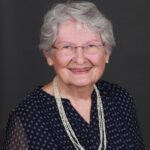 Smallpox rashes were first discovered on Egyptian Mummies 3,000 years ago. By the 1800’s a vaccine to prevent the spread of smallpox was discovered, and was eradicated in North America by 1952. It became a major focus of the WHO in West and Central Africa in 1971. Bloesser tells the story of the campaign in Africa–as told in her current book: Vaccines & Bayonets: Fighting Smallpox in Africa amid Tribalism, Terror and the Cold War. Click here
Smallpox rashes were first discovered on Egyptian Mummies 3,000 years ago. By the 1800’s a vaccine to prevent the spread of smallpox was discovered, and was eradicated in North America by 1952. It became a major focus of the WHO in West and Central Africa in 1971. Bloesser tells the story of the campaign in Africa–as told in her current book: Vaccines & Bayonets: Fighting Smallpox in Africa amid Tribalism, Terror and the Cold War. Click here
Oct. 11–Diane Ashton & Susan English: “Death and Dying: What to Say, How to Say it, and What Not to Say”
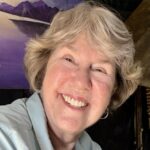
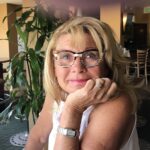 How do you know what to say when you don’t think you have (or know) the appropriate words for a dying person or for those who are grieving? As we know, effective communication is only 10% words, with the remainder being non-verbal both language, gestures, facial expressions and tone of voice. Click here
How do you know what to say when you don’t think you have (or know) the appropriate words for a dying person or for those who are grieving? As we know, effective communication is only 10% words, with the remainder being non-verbal both language, gestures, facial expressions and tone of voice. Click here
Oct. 9–Dan Duncan: “Guerrilla Filmmaking: Telling Stories with Picture and Sound”
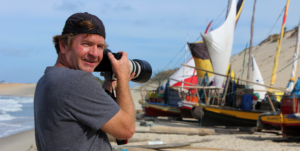 Emmy Award-Winning Dan Duncan, is the producer and director of the PBS series In the Americas with David Yetman. It is in its 11th year of production with 100 half-hour episodes. Duncan summarizes the technological advances for king movies over the last 150 years and showcases some of the current tools and techniques used in the PBS series. click here
Emmy Award-Winning Dan Duncan, is the producer and director of the PBS series In the Americas with David Yetman. It is in its 11th year of production with 100 half-hour episodes. Duncan summarizes the technological advances for king movies over the last 150 years and showcases some of the current tools and techniques used in the PBS series. click here
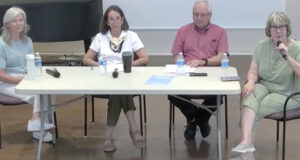 Oct. 5–A Panel Discussion: “Perspectives About End of Life Issues”
Oct. 5–A Panel Discussion: “Perspectives About End of Life Issues”
This panel addresses questions about how an end-of-life support personnel team works cooperatively to be of assistance to the patient, caretaker(s), family, and friends. Questions solicited in the last three lectures will be addressed, as well as new ones. Panel: Sharon Stetz, Dennis Ondrejka, Mary Ganopol, Yvette Brendice; moderated by Diane Ashton and Char Tosi. Click here
Oct. 4–Yvette Bredice: “End of Life: Doulas”
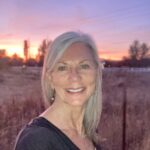 End-of-life doulas provide a range of non-medical holistic support to the dying person and their loved ones. Yvette Bredice, founder of Tucson End of Life Soulas, discusses the varied roles of an end-of-life doula, gives some examples from her previous cases, an describes who may benefit from the services of a “death doula”. Click here
End-of-life doulas provide a range of non-medical holistic support to the dying person and their loved ones. Yvette Bredice, founder of Tucson End of Life Soulas, discusses the varied roles of an end-of-life doula, gives some examples from her previous cases, an describes who may benefit from the services of a “death doula”. Click here
Sept. 28–Mary Ganopol: “Medical Aid in Dying”
 Mary Ganapol is the Southern Arizona lead for Arizona End of Life Options. She discusses end-of-life options, including medical aid in dying (MAID). MAID is legal in 10 states plus Washington D.C., and numerous bills have been proposed in the AZ legislature since 2003. Surveys indicate that over 60% of the AZ voters who respond favor passing the MAID bill. click here
Mary Ganapol is the Southern Arizona lead for Arizona End of Life Options. She discusses end-of-life options, including medical aid in dying (MAID). MAID is legal in 10 states plus Washington D.C., and numerous bills have been proposed in the AZ legislature since 2003. Surveys indicate that over 60% of the AZ voters who respond favor passing the MAID bill. click here
Sept. 27–Dennis Ondrejka: “Palliative Care and Hospice”
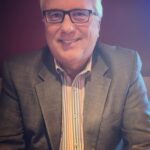 What is the difference between palliative care and hospice care? And when does the movement from one to another take place? Dr. Ondrejka, former professor, researcher, and author is now a spiritual support professional. He discusses the difference in the care of dying individuals, and other aspects of the process. click here
What is the difference between palliative care and hospice care? And when does the movement from one to another take place? Dr. Ondrejka, former professor, researcher, and author is now a spiritual support professional. He discusses the difference in the care of dying individuals, and other aspects of the process. click here
Sept.20– David Pietz: “Deep Dive into Water Issues: The Yellow River and Water Concerns in China”
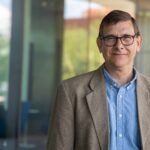 David Pietz is a Regents Professor of Chinese History and a UNESCO Chair in Environmental History. He notes that Northern China is experiencing a water problem: nature and culture have conspired to shape the waterscape of the North China Plain. However, this region has confronted this challenge for centuries in often remarkable and effective ways. Dr. Pietz describes the region, its water problems and how it has confronted them in the past. Click here
David Pietz is a Regents Professor of Chinese History and a UNESCO Chair in Environmental History. He notes that Northern China is experiencing a water problem: nature and culture have conspired to shape the waterscape of the North China Plain. However, this region has confronted this challenge for centuries in often remarkable and effective ways. Dr. Pietz describes the region, its water problems and how it has confronted them in the past. Click here
Sept. 18: Betsy Boggia: “Introduction to Ranked Choice Voting”
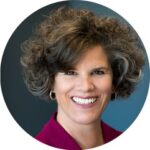 Betsy Boggia of the Southern Arizona of Organizer of the Voter Choice Arizona, discusses how Voter Choice Arizona supports Ranked Choice Voting. This is a way for voters to have more choice and more voice, and contributes to better governance and a better Arizona.In addition to her work with Voter Choice Arizona, she serves on the board of the League of Women Voters, Greater Tucson. Click here
Betsy Boggia of the Southern Arizona of Organizer of the Voter Choice Arizona, discusses how Voter Choice Arizona supports Ranked Choice Voting. This is a way for voters to have more choice and more voice, and contributes to better governance and a better Arizona.In addition to her work with Voter Choice Arizona, she serves on the board of the League of Women Voters, Greater Tucson. Click here
Sept. 9: Susanna Eden: “”Tucson Active Management Area: Water Outlook”
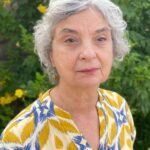 Dr. Susanna Eden, currently associated with the U of A’s Water Resources Research Center, focuses on the 1980 Groundwater Management Act and subsequent legislation relating to the rights to use groundwater, including for municipal and domestic consumption. An important aspect of the law was the substitution of Central Arizona Project water for groundwater by water companies such as the Spanish Trail. She discusses recent events that have highlighted problems with the current legal framework. Click here
Dr. Susanna Eden, currently associated with the U of A’s Water Resources Research Center, focuses on the 1980 Groundwater Management Act and subsequent legislation relating to the rights to use groundwater, including for municipal and domestic consumption. An important aspect of the law was the substitution of Central Arizona Project water for groundwater by water companies such as the Spanish Trail. She discusses recent events that have highlighted problems with the current legal framework. Click here
Gary Fenstermacher: “Envisioning a Different Way to Retire–The First Quarter Century of Academy Village”
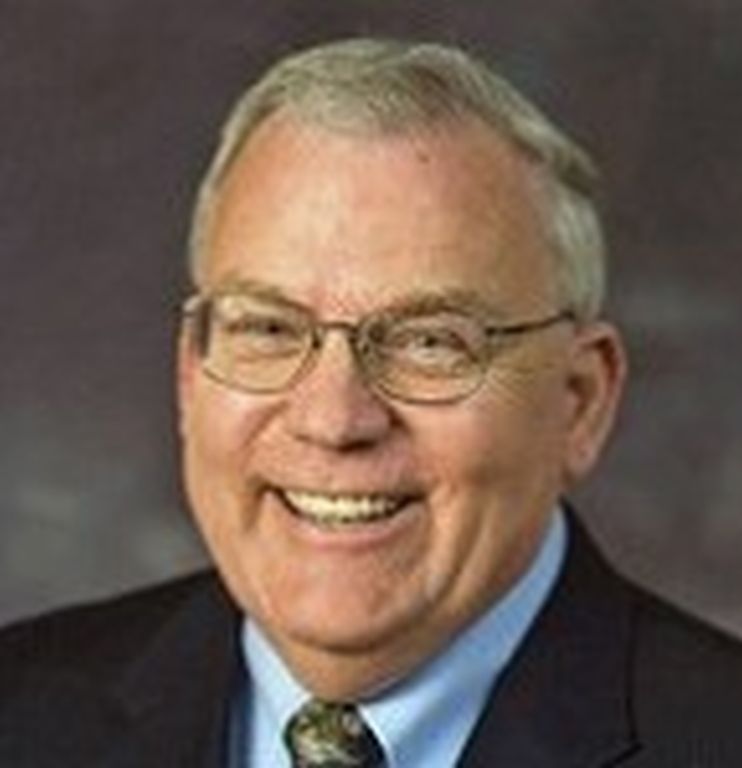 Gary Fenstermacher, emeritus professor at the University of Michigan, has lived in Academy Village for 15 years. He examines Henry Koffler’s founding vision for Academy Village, the five years of planning that preceded the first home in the Village, and the two decades since. Fenstermacher considers events in the early 2,000’s that altered Koffler’s vision, sometimes for the better and sometimes not. Click here
Gary Fenstermacher, emeritus professor at the University of Michigan, has lived in Academy Village for 15 years. He examines Henry Koffler’s founding vision for Academy Village, the five years of planning that preceded the first home in the Village, and the two decades since. Fenstermacher considers events in the early 2,000’s that altered Koffler’s vision, sometimes for the better and sometimes not. Click here
August 28: Xiaochang Chen: “The Parker Solar Probe”
 Xiaochang ChenNASA’s Parker Solar Probe (PSP) is on its way to the sun. The mission was named after Dr. Eugene Parker who predicted that the Sun’s atmosphere is so hot that solar gases must shoot out in a form called the solar wind. The PSP will fly close enough to the Sun to obtain the data needed to figure out how the corona gets so hot and details related to the solar sun. Mr. Chen, a 5th year graduate student at the U of A talks about the PSP mission. Click here
Xiaochang ChenNASA’s Parker Solar Probe (PSP) is on its way to the sun. The mission was named after Dr. Eugene Parker who predicted that the Sun’s atmosphere is so hot that solar gases must shoot out in a form called the solar wind. The PSP will fly close enough to the Sun to obtain the data needed to figure out how the corona gets so hot and details related to the solar sun. Mr. Chen, a 5th year graduate student at the U of A talks about the PSP mission. Click here
August 21: Chuck Tampio: “Who is the Greatest Dutch Master: Rembrandt, Vermeer, or Van Gogh”
With the growth of the middle class in the 17th century in Holland, artists became free to depict scenes of daily lives as well as still lives, landscapes and urban scenes. Chuck Tampio makes a case that Rembrandt, Vermeer, and VanGogh were the greatest painters in Dutch history by describing these artists and their art. He then challenges the audience to name the artist that most engages them. Click here
August 14: Brandon Strange: “The Impact of Megadrought on Ponderosa Pine Forests in the Southeast U.S.”
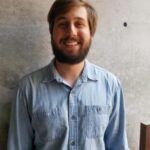 Most Southern Arizonans have visited the beautiful Ponderosa forests of Northern Arizona but may not be aware of the effects of the mega draught on these forests. Dr. Brandon Strange, of Watershed Management and Ecohydrology, studies the rings that appear each year in tree trunks that are used as a way of calculating the dates of particular events.He uses these rings and stable isotope biochemistry to examine how forests function and how they are responding to climate change. Click here
Most Southern Arizonans have visited the beautiful Ponderosa forests of Northern Arizona but may not be aware of the effects of the mega draught on these forests. Dr. Brandon Strange, of Watershed Management and Ecohydrology, studies the rings that appear each year in tree trunks that are used as a way of calculating the dates of particular events.He uses these rings and stable isotope biochemistry to examine how forests function and how they are responding to climate change. Click here
July 17: Cynthia Meier & Joseph McGrath, Co-Founders of The Rogue Theatre
 The Rogue Theatre is an intimate 160-seat, small professional theatre located in the heart of Tucson in the Historic ‘Y’. The shape of the stage and the seating arrangement of the audience changes to meet the particular needs of the production. Co-Founders Jo McGrath and Cindy Meier describe the Rogue theatre and present its upcoming season. Click here
The Rogue Theatre is an intimate 160-seat, small professional theatre located in the heart of Tucson in the Historic ‘Y’. The shape of the stage and the seating arrangement of the audience changes to meet the particular needs of the production. Co-Founders Jo McGrath and Cindy Meier describe the Rogue theatre and present its upcoming season. Click here
July 24: Hubert Parker: “Tucson Wildlife Center, Saving the Wildlife of Tucson and Southern Arizona for 24 years!”
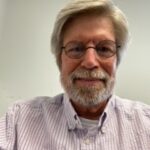 Hubert Parker, Development Director for the Tucson Wildlife Center, sums up its mission in three words beginning with ‘R’: Rescue, Rehab, Release. The Center takes in sick, injured, or orphaned wildlife. Hubert shares how they work from intake to release by following different patients and how they meet some of the challenges. The Center is a 501(c)3, and survives on donations as well as volunteers.Click here
Hubert Parker, Development Director for the Tucson Wildlife Center, sums up its mission in three words beginning with ‘R’: Rescue, Rehab, Release. The Center takes in sick, injured, or orphaned wildlife. Hubert shares how they work from intake to release by following different patients and how they meet some of the challenges. The Center is a 501(c)3, and survives on donations as well as volunteers.Click here
July 10: Alex La Pierre: “The First Filibusters: French and Mexican Incursions into Sonora”
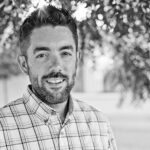 Historian Alex La Pierre focusses on the Sonoran incursions made by French and American “filibusters” who made lasting impacts on the heritage of Arizona. The term became “filibusters”, but originally referred to foreign and often stateless mercenaries who sought to carve out territories in Latin America. Alex La Pierre is the co-founder of Borderland, a by-national organization committed to building public understanding of the borderlands (American Southwest and Mexico). Click here
Historian Alex La Pierre focusses on the Sonoran incursions made by French and American “filibusters” who made lasting impacts on the heritage of Arizona. The term became “filibusters”, but originally referred to foreign and often stateless mercenaries who sought to carve out territories in Latin America. Alex La Pierre is the co-founder of Borderland, a by-national organization committed to building public understanding of the borderlands (American Southwest and Mexico). Click here
July 17. John Muniz: An Invitation to Atonal Music: Or How I learned to stop Worrying and Love Cluster Chords”
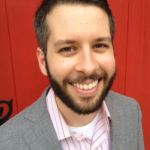 In his second presentation about classical music at Academy Village, John Muniz helps us learn how to listen to and appreciate atonal music. Many in the audience agreed that they had issues with such music. Muniz, Associate Professor of Music theory at the University of Arizona, suggests that order and beauty lie hidden within atonal music, and that even its chaos– when heard correctly–can be sublime. Click here
In his second presentation about classical music at Academy Village, John Muniz helps us learn how to listen to and appreciate atonal music. Many in the audience agreed that they had issues with such music. Muniz, Associate Professor of Music theory at the University of Arizona, suggests that order and beauty lie hidden within atonal music, and that even its chaos– when heard correctly–can be sublime. Click here
June 26: Shaku Nair: “Are All Termites Terrible?”
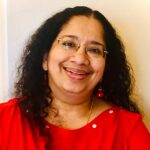 Dr. Shaku Nairn, Extension Entomologist at the University of Arizona, provides an overview of the termites found in Arizona, termite behavior and behavior, pointers regarding early detection and management, myths about termites, and comparison between termites and their lookalikes and a few other wood destroying insects. Click here
Dr. Shaku Nairn, Extension Entomologist at the University of Arizona, provides an overview of the termites found in Arizona, termite behavior and behavior, pointers regarding early detection and management, myths about termites, and comparison between termites and their lookalikes and a few other wood destroying insects. Click here
June 19. Janice Jarrett: “How we Learn: Music as a Metaphor”
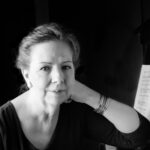 What can explain the fact that musicians are quantifiably “better” learners? Dr. Jarrett explains how music is like a language and can be as daunting to learn as gaining fluency in another language. Jarrett describes what neuroscientists are now saying about this form of brain activity, and how musicians are better learners than non-musicians. (please excuse the lost few minutes of the lecture). Click here
What can explain the fact that musicians are quantifiably “better” learners? Dr. Jarrett explains how music is like a language and can be as daunting to learn as gaining fluency in another language. Jarrett describes what neuroscientists are now saying about this form of brain activity, and how musicians are better learners than non-musicians. (please excuse the lost few minutes of the lecture). Click here
June 12. Gary Fenstermacher: “The Humble Postage Stamp”
 Gary Fenstermacher, a stamp-collector since 1948, describes the creation and production of modern postage stamps. His collection is contained in more than 60 albums, covering nearly 80 linear feet of shelving. He addresses many questions related to stamps: the paper used, printing methods, how they are formatted, etc. He hopes that viewers will come away with a renewed appreciation for that little piece of paper that permits us to send many types of items across country and around the world. Click here
Gary Fenstermacher, a stamp-collector since 1948, describes the creation and production of modern postage stamps. His collection is contained in more than 60 albums, covering nearly 80 linear feet of shelving. He addresses many questions related to stamps: the paper used, printing methods, how they are formatted, etc. He hopes that viewers will come away with a renewed appreciation for that little piece of paper that permits us to send many types of items across country and around the world. Click here
June 6. Jennifer Shi: “Hearing Loss and Hearing Aid Technology”
 Dr.Jennifer Shi, a clinical Doctor of Audiology, currently practices at Arizona Hearing Specialists in Tucson. She reviews the different types of hearing loss, and how to read an audiogram. She presents some general information on the relationship between hearing loss and balance, as well as best practices in audiology and how it is performed. Click here
Dr.Jennifer Shi, a clinical Doctor of Audiology, currently practices at Arizona Hearing Specialists in Tucson. She reviews the different types of hearing loss, and how to read an audiogram. She presents some general information on the relationship between hearing loss and balance, as well as best practices in audiology and how it is performed. Click here
May 24: Adam Block, “Echoes of a Forgotten Sky”
 Adam Block is founder of the Mount Lemmon SkyCenter, and a researcher at the Stewart observatory, University of Arizona. In this presentation, Block introduces the art of astrophotography and how to interpret the images we see in this time of advances in sky photography. Block’s work as astronomer has resulted in the discovery of asteroids (one was named in his honor) as well as extra-galactic star streams and supernova. His photography have been published in a number of magazines. Click here
Adam Block is founder of the Mount Lemmon SkyCenter, and a researcher at the Stewart observatory, University of Arizona. In this presentation, Block introduces the art of astrophotography and how to interpret the images we see in this time of advances in sky photography. Block’s work as astronomer has resulted in the discovery of asteroids (one was named in his honor) as well as extra-galactic star streams and supernova. His photography have been published in a number of magazines. Click here
May 17: Ian MacSpadden, “The Future of Public Television and Radio–Why They are Still Relevant”
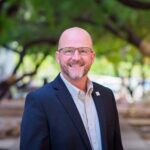 Ian MacSpadden is the Chief Technology Officer of the Arizona Public Media. He gives a brief history of radio and television and the technology they have used. He then moves to the area of advancements in the digital age and how they affect public media.He examines the differences between the for-profit and public media and how the public media remain a leader in the development and use of curing edge technologies. By doing so, he indicates that public media will be able to maintain its relevancy and audience. Click here
Ian MacSpadden is the Chief Technology Officer of the Arizona Public Media. He gives a brief history of radio and television and the technology they have used. He then moves to the area of advancements in the digital age and how they affect public media.He examines the differences between the for-profit and public media and how the public media remain a leader in the development and use of curing edge technologies. By doing so, he indicates that public media will be able to maintain its relevancy and audience. Click here
May 15: Mary-Frances O’Connor, “The Grieving Brain”
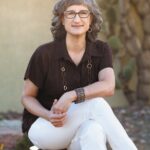 Dr. O’Connor, Associate Professor of Psychology, U of A, a leader in the field of neuroscience, has devoted her entire career to the study the ‘why” of grief and grieving. She talks about grief through the lens of both scientist and griever and discuss the difference between grief–the painful feeling we have when we lose a loved one–and grieving–the process of adapting to our grief over time. Click here
Dr. O’Connor, Associate Professor of Psychology, U of A, a leader in the field of neuroscience, has devoted her entire career to the study the ‘why” of grief and grieving. She talks about grief through the lens of both scientist and griever and discuss the difference between grief–the painful feeling we have when we lose a loved one–and grieving–the process of adapting to our grief over time. Click here
May 10: Carol A. Barnes, “Precision Aging Network: Developing Methods to Optimize Brain Health”
 Dr. Barnes, the Director of the Evelyn F. Knight Brain Institute and U of A Regents’ Professor, describes a 5-year study on brain aging, which considers genetics, lifestyle, environment and other variables to determine what factors optimize brain health as we age. The purpose is to learn how to predict, prevent, or slow the decline of brain aging. Click here
Dr. Barnes, the Director of the Evelyn F. Knight Brain Institute and U of A Regents’ Professor, describes a 5-year study on brain aging, which considers genetics, lifestyle, environment and other variables to determine what factors optimize brain health as we age. The purpose is to learn how to predict, prevent, or slow the decline of brain aging. Click here
May 8: Abby Hungwe, “Healing-Centered Engagement for Refugee Families”
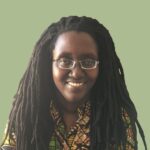 Abby Hungwe shares her experience as an asylum seeker from Zvishavane, Zimbabwe. She completed her graduate studies at Southern Arkansas University, and is passionate about community building and community education. She is now the Managing Director of the Owl and Panther, an organization that works to provide refugee children and their families with healing experiences and a welcoming community. Click here
Abby Hungwe shares her experience as an asylum seeker from Zvishavane, Zimbabwe. She completed her graduate studies at Southern Arkansas University, and is passionate about community building and community education. She is now the Managing Director of the Owl and Panther, an organization that works to provide refugee children and their families with healing experiences and a welcoming community. Click here
May 3: Steve Sarper, “The Life and Music of Gustav Mahler”
 Gustav Mahler is said to have bridged the musical traditions of the 19th and 20th century, but whose work has been most appreciated since the 1960’s. Steve Sarper presents sections from different compositions of Mahler which show how he used sound and mood to create an impact on his audience. He address why it took so many years for the music world to recognize him as an important composed,, which musicians influenced him, and what it was like to work as a composer. Click here
Gustav Mahler is said to have bridged the musical traditions of the 19th and 20th century, but whose work has been most appreciated since the 1960’s. Steve Sarper presents sections from different compositions of Mahler which show how he used sound and mood to create an impact on his audience. He address why it took so many years for the music world to recognize him as an important composed,, which musicians influenced him, and what it was like to work as a composer. Click here
April 24: Barbara Rogers, “The Necessity of Beauty”
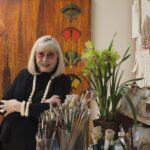 Barbara Rogers, Emerita Professor of Art in the University of Arizona School of Art, is an internationally known painter whose work hangs in at least nineteen major public and private collections. In this presentation, Rogers describes the evolution of her approaches as she changes from romantic realism to a hybrid vision that has grown “increasingly complex and ambitious”. Click here
Barbara Rogers, Emerita Professor of Art in the University of Arizona School of Art, is an internationally known painter whose work hangs in at least nineteen major public and private collections. In this presentation, Rogers describes the evolution of her approaches as she changes from romantic realism to a hybrid vision that has grown “increasingly complex and ambitious”. Click here
April 17: Jason Wright, “Outsmart the Scammers”
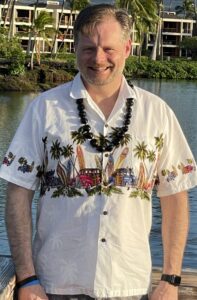 Incidents of financial fraud and identity are on the rise.Jason wright, an Edward Jones Financial Advisor, suggests that while no one is immune from these scammers, it is possible to limit the chance of becoming another victim. He focuses on the most prevalent fraud schemes being used today and explains what actions we can take to minimize our vulnerabilities to them. Click here
Incidents of financial fraud and identity are on the rise.Jason wright, an Edward Jones Financial Advisor, suggests that while no one is immune from these scammers, it is possible to limit the chance of becoming another victim. He focuses on the most prevalent fraud schemes being used today and explains what actions we can take to minimize our vulnerabilities to them. Click here
April 12: Dr. Gregory Walker, Jr., “Common Ailments of the Foot & Ankle”
 Feet are so important to everything we do and everywhere we go, that when our feet are out of commission, so are we. Dr. Walker, an Orthopedic surgeon, Foot & Ankle specialist at Northwest Affiliated Physicians at Northwest Hospital, addresses several of the most common ailments of the feet and ankle that put us in the slow lane when we would rather not be. Click here
Feet are so important to everything we do and everywhere we go, that when our feet are out of commission, so are we. Dr. Walker, an Orthopedic surgeon, Foot & Ankle specialist at Northwest Affiliated Physicians at Northwest Hospital, addresses several of the most common ailments of the feet and ankle that put us in the slow lane when we would rather not be. Click here
April 5: Don E. Swann, “The Saguaro Census at Saguaro National Park”
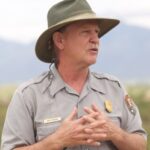 Don E Swan, a biologist who has worked at Saguaro National Park for over 30 years, and has been a author or co-author on more than 20 scientific papers on the saguaro and other Sonoran Desert plants. He discusses the “citizen science” program that the park does every 10 years to monitor the health of the signature species–the Saguaro. He also who’s how it has changed over the past 80 years, and how it may change in the future. Click here
Don E Swan, a biologist who has worked at Saguaro National Park for over 30 years, and has been a author or co-author on more than 20 scientific papers on the saguaro and other Sonoran Desert plants. He discusses the “citizen science” program that the park does every 10 years to monitor the health of the signature species–the Saguaro. He also who’s how it has changed over the past 80 years, and how it may change in the future. Click here
April 3: James Lange– “Optimizing Planning to Secure Your Retirement and Preserve Your Estate”
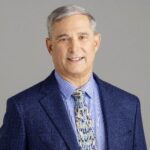 James Lange, a CPA, Attorney, and registered investment advisor, and is the author of 8 books that help protect the financial security of IRA and retirement plan for owners and their families. In this talk, he provides information on the latest techniques for minimizing taxes but also strategies for estate planning and charitable giving. Working within the TIAA system, he explains some helpful strategies, thought to be eliminated but that are still permitted by TIAA. Click here
James Lange, a CPA, Attorney, and registered investment advisor, and is the author of 8 books that help protect the financial security of IRA and retirement plan for owners and their families. In this talk, he provides information on the latest techniques for minimizing taxes but also strategies for estate planning and charitable giving. Working within the TIAA system, he explains some helpful strategies, thought to be eliminated but that are still permitted by TIAA. Click here
March 29: Fred Skinner–“Beethoven in Russia: Music & Politics”
 Dr. Fred Skinner’s passion and for Beethoven’s music and expertise in Russian history combine in this intriguing look at the interaction of culture and politics. ‘Beethoven in Russia: Music and Politics’ shows how Beethoven’s music served as a call for action for citizens, and weaponized state propaganda on the great political struggles that shaped modern Russian history. Click here
Dr. Fred Skinner’s passion and for Beethoven’s music and expertise in Russian history combine in this intriguing look at the interaction of culture and politics. ‘Beethoven in Russia: Music and Politics’ shows how Beethoven’s music served as a call for action for citizens, and weaponized state propaganda on the great political struggles that shaped modern Russian history. Click here
March 27: Diana Netherton Part II: Becoming More Hydro-Local–Restoring Desert Landscapes One Yard at a Time”
 Diana Netherton retired from a career in Pediatric nursing to sheep farming in Montana, and is now a desert dweller in Academy Village. In this presentation, she examines the strategies to help restore natural health to a landscape through examples of her approach on her .25-acre plot . This involves capturing rain water from roofs, choosing native grasses, and planting pollinators. Click here
Diana Netherton retired from a career in Pediatric nursing to sheep farming in Montana, and is now a desert dweller in Academy Village. In this presentation, she examines the strategies to help restore natural health to a landscape through examples of her approach on her .25-acre plot . This involves capturing rain water from roofs, choosing native grasses, and planting pollinators. Click here
March 20: Charles Tampio–“The Horse of Course: A History of Equine Art”
 Charles Tampio, a Horse owner and docent at the University Museum of Art and the Tucson Museum of Art, traces the earliest known images of horses in cave art and continues through to the most contemporary examples. Every medium, genre, and artistic period has featured horses, possibly the most important subject besides the human body. Click here
Charles Tampio, a Horse owner and docent at the University Museum of Art and the Tucson Museum of Art, traces the earliest known images of horses in cave art and continues through to the most contemporary examples. Every medium, genre, and artistic period has featured horses, possibly the most important subject besides the human body. Click here
March 15: “Northern Stars, Starry Skies”–Bob Foucault
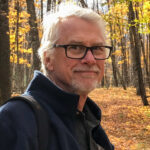 “Norther Nights, Starry Skies” is a documentary film that celebrates the value of preserving the night sky. Bob Foucault, an Academy Village resident, started his own film company–Aurora Pictures–and produced corporate communication and educational programming for over 30 years. The documentary shown in this presentation was one of many produced by Foucault. Click here to see the opening and Q&A sections of the program that includes a link to the actual documentary.
“Norther Nights, Starry Skies” is a documentary film that celebrates the value of preserving the night sky. Bob Foucault, an Academy Village resident, started his own film company–Aurora Pictures–and produced corporate communication and educational programming for over 30 years. The documentary shown in this presentation was one of many produced by Foucault. Click here to see the opening and Q&A sections of the program that includes a link to the actual documentary.
March 8: Denice Smith–A Guide to Becoming More Hydro-local: An Intro to Water Harvesting Design
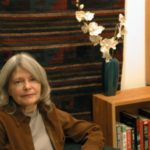 Tucson receives an average annual rainfall of 11″, often as torrential storms that cause flooding and erosion. Dr. Denise Smith, an Academy Village resident and R& D Scientist, provides information on water harvesting steps to reduce our demand on the local aquifer. These steps might incorporate infiltration basins, rainwater tanks, and/or a laundry to landscape approach to meet these needs. Click here
Tucson receives an average annual rainfall of 11″, often as torrential storms that cause flooding and erosion. Dr. Denise Smith, an Academy Village resident and R& D Scientist, provides information on water harvesting steps to reduce our demand on the local aquifer. These steps might incorporate infiltration basins, rainwater tanks, and/or a laundry to landscape approach to meet these needs. Click here
March 6: Deb Dale–“Bridging Communities: Public Media in Southern Arizona for the next 60 Years and Beyond”
 Deb Dale, the Chief Development Officer for Arizona Public Media, provides a history of public media in the U.S. and Southern Arizona over the pst 60 years. She then describes exciting new plans for Arizona Public Media, including a new broadcasting campus at the U of Arizona Tech Park. This activity will be a ‘Next Gen’ building designed to expand public media services, visibility and ease of use to residents of 11 counties throughout Arizona. Click here
Deb Dale, the Chief Development Officer for Arizona Public Media, provides a history of public media in the U.S. and Southern Arizona over the pst 60 years. She then describes exciting new plans for Arizona Public Media, including a new broadcasting campus at the U of Arizona Tech Park. This activity will be a ‘Next Gen’ building designed to expand public media services, visibility and ease of use to residents of 11 counties throughout Arizona. Click here
Sept. 30: Jim Kolbe–“Is the American Experiment with Democracy Coming to Its End?
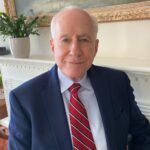 Jim Kolbe is the Former Congressman from Arizona’s 5th District and a public affairs consultant. In these days of fraught political events, politicized political life, and divided loyalties, many seek clarity and hope for America’s future. There are, however, efforts to achieve bipartisan accord through newly emerging political movements. Congressman Kolbe addresses some of this work, including the “fusion” effort. Click here
Jim Kolbe is the Former Congressman from Arizona’s 5th District and a public affairs consultant. In these days of fraught political events, politicized political life, and divided loyalties, many seek clarity and hope for America’s future. There are, however, efforts to achieve bipartisan accord through newly emerging political movements. Congressman Kolbe addresses some of this work, including the “fusion” effort. Click here

